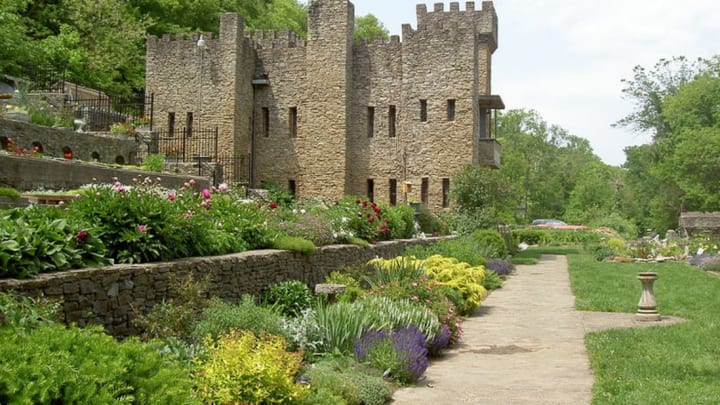Ohio's Loveland Castle Was Hand-Built By a Midwestern Medievalist

Located approximately 15 miles northeast of the Cincinnati city limits, Loveland, Ohio, is home to around 12,000 people and one reportedly haunted castle. While the Château Laroche—or Loveland Castle, as the locals call it—has a fascinating heritage, the story behind its creator, Harry Delos Andrews, is equally intriguing.
Born April 5, 1890, Andrews was a medievalist who objected to modern warfare and preferred sword-to-sword combat. As a conscientious objector, Andrews joined the World War I effort as a medic (although he sometimes claimed he was a courier between President Woodrow Wilson and General John Pershing). But, at the beginning of his military career, he contracted cerebrospinal meningitis. Andrews was presumed dead, but for some reason one of the attending physicians decided to administer a new drug, adrenaline, and his heart began to beat again.
By the time Andrews was officially declared undead six months later, his fiancée had married another man. (Andrews himself never married, although he reportedly turned down as many as 50 marriage proposals after a news story pointed out that the man with the castle was a bachelor.) And after a lengthy recovery, Andrews was stationed at Château de la Roche in southern France, where he served as a hospital administrator. The time in France left a lasting impression on Andrews, and would eventually influence the name of his life’s work.
In the 1920s, one of Andrews’ projects was his Boy Scout-esque troop, which he named the Knights of the Golden Trail (KOGT). The group often camped along the shore of the Little Miami River, which bisects Loveland. The two plots where the group stayed were donated by families of the scouts, who obtained the land through a subscription promotion held by the Cincinnati Enquirer newspaper. The KOGT spent so much time on the site that they began to leave their camping gear there, leading Andrews to want to build two stone structures as shelters. Of course, the combination of knights and stone abodes led Andrews to decide that a castle needed to be built.
Andrews began construction in 1929. The structure is comprised of rocks pulled from the riverbed of the Little Miami, bricks he formed himself by pouring concrete into milk containers, and even stones given to him by visitors. Andrews modeled Château Laroche after a 16th century castle, but updated the floorplan to include modern rooms such as an office, garage, and junk room (though he made sure to include a dungeon and imprisonment tower, because what castle is complete without them?). Among its many facilities is a hidden room in the garden, accessible through one of the arches, which was discovered after Andrews’ death in 1981.
As Andrews told it, “Château Laroche was built as an expression and reminder of the simple strength and rugged grandeur of the mighty men who lived when Knighthood was in flower." And the castle allegedly had American royalty among its fans. The King—Elvis Presley—reportedly visited Château Laroche multiple times and even offered to buy it. Andrews refused, and ultimately willed the castle and its ground to the Knights of the Golden Trail, who maintain it to this day.
Now, the Loveland Castle is open to visitors and regularly hosts a variety of activities from tours to picnics to overnights. One of the highlights is the annual Halloween Scary Knight Tour. And, yes, the Loveland Castle is rumored to be haunted. Andrews reportedly told visitors that a spirit named Casper Poltergeist inhabited the building, as all castles should have a ghost. And though that tale was merely something out of Andrews' imagination, some people believe that "Sir Harry" Andrews himself—whose remains were scattered on the property—now haunts his beloved castle.